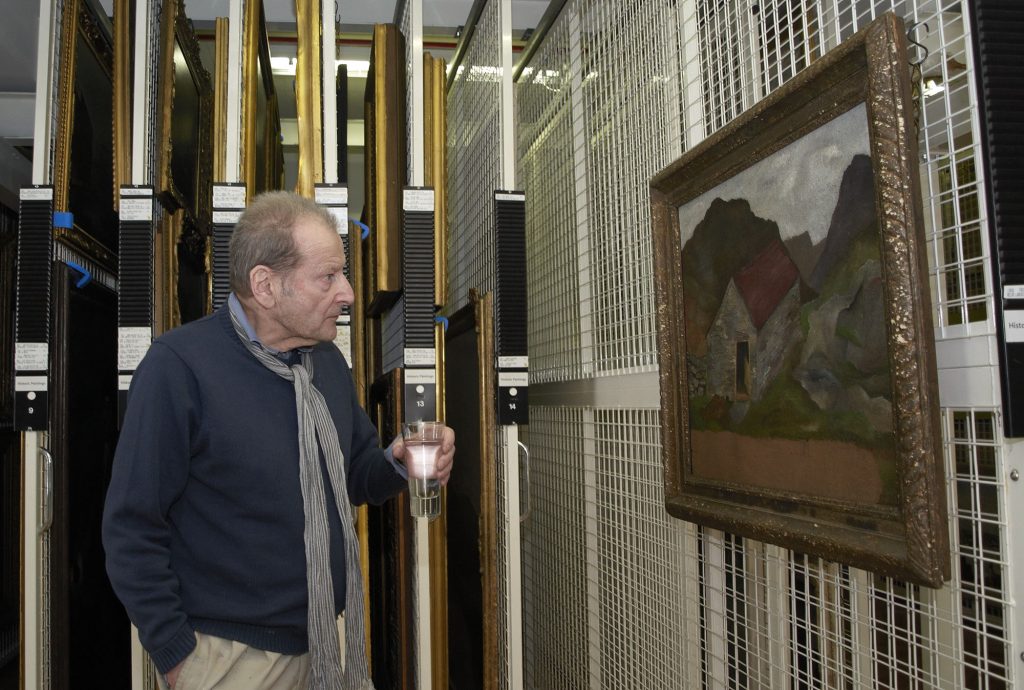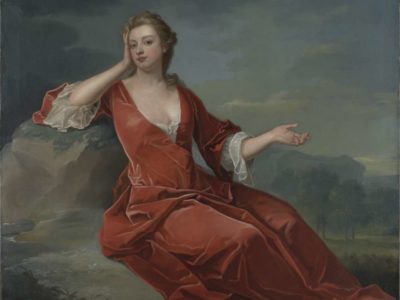A closer look: Lucian Freud’s Welsh Landscape
Lucian Freud, one of the UK's most distinguished artists, died in 2011 at the age of 88. His career spanned over six decades and featured hundreds of paintings, etchings and drawings.
In 2008, Lucian Freud, accompanied by his assistant David Dawson (who also has works in the Collection) came to the headquarters of the Government Art Collection to revisit his work Welsh Landscape, painted between 1939 and 1940. Clearly moved, the artist placed his hands on the surface of the painting, in a gesture that showed his emotional reconnection with the work.

Lucian Freud visiting the Government Art Collection in 2011. © Crown Copyright
Freud was just 17 in 1939 when he went to stay in Capel Curig, North Wales, accompanied by his friend David Kentish, and the poet Stephen Spender. They rented rooms in a small house called Haulfryn (sunny hill in Welsh) from a retired quarryman, Evan Pritchard, for three pounds and ten shillings a week. Freud painted Welsh Landscape while he stayed there; it was one of several paintings, ink drawings and sketches he made during the visit.

Lucian Freud (1922 – 2011), Welsh Landscape, 1939-1940 © Lucian Freud Archive / Bridgeman Images.
The building depicted is the bothy, or small mountain hut, in which Freud painted alone every day. The same bothy appears in another well-known work by him, Box of Apples in Wales (currently in a private collection). The landscape is an early example of Freud’s dexterity at applying varied brushstrokes to create different textured surfaces of paint. He would later develop these techniques to more striking effects in his famous nude portraits. In Welsh Landscape, Freud used a succession of rapid brushstrokes for the bothy’s walls to create a mosaic-like surface for the rough stone of the building. In contrast, the dappled blends of dark browns, mauve, greens and greys of the surrounding landscape and mountains appear more ethereal in treatment.
Lucian Freud was born in Berlin, the grandson of the great Austrian psychoanalyst Sigmund Freud and brother to actor Clement Freud. A Jewish family, they fled from Germany in 1933 and settled in London. Largely self-taught, Freud was encouraged from an early age to develop his interest in art; hanging on his walls at home he would see reproductions of early Northern European art including paintings and woodcuts by German artist Albrecht Dürer (1471–1528).
Both Welsh Landscape and Box of Apples in Wales were painted during the first months of the Second World War. Their vision is severe and unforgiving. As several critics have remarked, these early pictures share a directness and unblinking concentration upon the world, as if the artist was able to see for the first time. Even at this early stage in his career, Freud demonstrates the impact of focusing on a single motif or subject, managing in Welsh Landscape to convey his affection for the hut and its solitary location. At the same time, the raw intensity of the work is disquieting and points towards the uneasy tension that pervades his later works and for which Freud became so well known.
Lucian Freud’s Welsh Landscape was on loan to the Victoria Art Gallery in Bath, for the exhibition Freud, Minton, Ryan: unholy trinity (10 July-19 September 2021).


